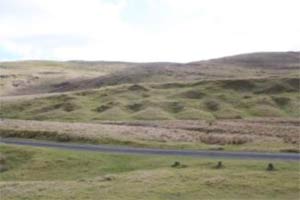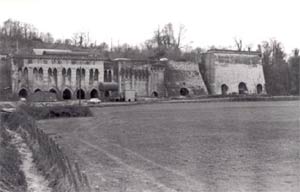The use of lime as a fertiliser is generally thought not to have been common practice until the 16th century. As the market for lime as a fertiliser, in industry and as a building material increased, the scale of lime production became more industrialised and the design of kilns became larger and more efficient. At Herbert's Quarry and the surrounding area a unique collection of different sizes and types of lime kilns can be identified, spanning many of the changes in the development of kilns.
This extract from a translation of a Welsh manuscript indicates how agricultural lime was made in medieval times:
Cut gorse, ferns, thorns, and underwood, in winter, where limestone is at hand; plough a ridge seven yards wide; place thereon a layer of fuel, then limestone, and so on alternatively to the height of three yards; and make flues in the fuel in all directions, that the fire may pervade the whole heap. Then cover the kiln with sods, and upon those, clay or marl; then set fire to it, and when it is well kindled, stop the mouths of the flues, and let it burn until the fire breaks out through the clay or marl; then cover again, and so on, until the fire breaks out the third time, when it will have burned sufficiently: when cooled a little, open it, and carry the lime to where it is wanted. Bestow lime once in nine years upon arable land and once in 18 years upon grassland.
This type of kiln is called a 'Clamp Kiln'. Very little visible evidence of this method of making lime survives above ground. |
|
The clamp kiln method was replaced by the Flare kiln, a larger structure where the fuel source was separated from the limestone. These kilns produced clean lime but had to be partly dismantled to extract the lime. |
|
In Draw Kilns, fuel and limestone were mixed in layers. These kilns were designed to be operated continuously (on a seasonal basis), but were not necessarily used in this way. They are constructed from stone, built against (out from) a natural bank usually with the charging hole flush with the quarry floor. According to Davies (1815) this type of kiln was introduced to south Wales in about 1775. They continued to be built into the early 20th century and some were used up to the 1970s. |
Types of kiln on the Black Mountain

|
A row of Flare Kilns at Brest Cwm Lloyd. These kilns had to be taken apart to dig out the lime, and had to be rebuilt if they were used again. Only a small amount of lime was produced each time the kiln was used. Because they are small, and not built entirely out of stone their remains are sometimes difficult to see. |
|
From the end of the eighteenth century, Flare Kilns were replaced with Draw Kilns. These kilns were larger than the Field Kilns and could be re-used without rebuilding. This example in the Clogau Bach quarries can be recognised by its size and because it is built out from the hill slope. |
|
This is a much larger Draw Kiln terraced into the hill slope below the Craig y Nos and Blaen y Gwawr quarries. Because the kiln is cut into the hillside instead of being built out from it, it holds its heat more efficiently. This kiln could be kept burning for longer, by removing ash and lime from the bottom while refilling with stone and coal from the top. |
|
This is a modernised Draw Kiln in the Craig y Nos and Blaen y Gwawr quarries. It has been refaced with stone and has a brick kiln lining. |
|
The lime was collected from the bottom of the kiln in a 'dram' that was moved on rails. |
|
This modernised kiln in the Foel Fawr quarries has been encased in concrete, but does not appear to have been adapted to use 'drams'. |
The most efficient kilns were built joined together in rows forming a solid bank. They were designed for large scale industrial production of lime. These examples are at Henhllys Vale and at the Cilyrychen Quarries in Llandybie. Much more money was invested in the construction of 'Bank Kilns' and their remains have survived better.
|

Amgueddfa Cymru - National Museum Wales
|
The Limekilns at Cilyrychen Quarry, c.1970s. Their designs and dates vary considerably; from left to right: mid C19 ornate masonry kilns designed by quarry proprietor Richard Kyrke Penson, a notable church architect; later less ornate masonry and mass concrete kilns that echo the architecture of the first block; a massive plain C19 masonry kiln and a bank of three early C20 concrete kilns. |
